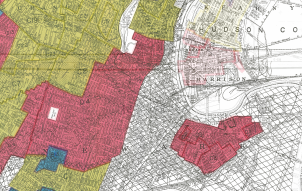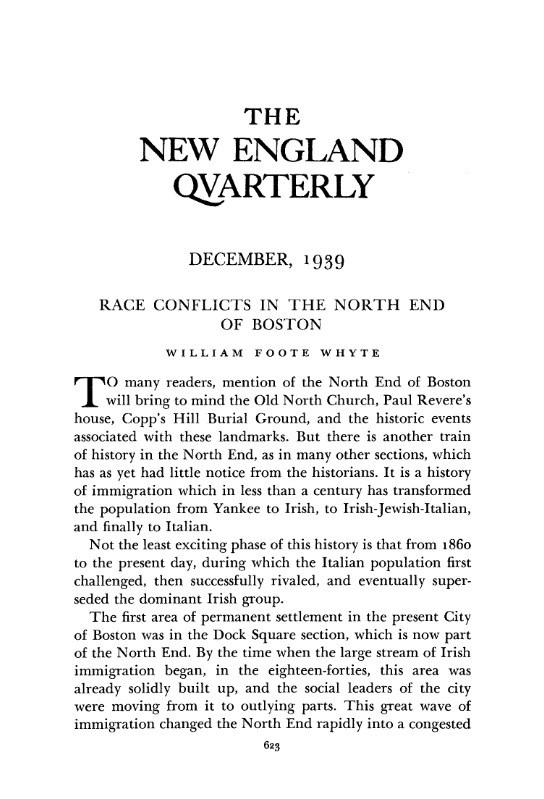Making The Best Of What They Had
The book discusses the the living area of Italian immigrants in the state of New Jersey. Two towns that many immigrants moved to were Bellville and Newark. There is mention of these two towns being very poor and a hot spot for immigrants. The author discusses how the land that made up these towns was once used as a place to dump garbage. When Italians arrived, they would build their homes themselves and create a tight knit community that resembled their home country. During this time, ethnic enclaves were seen throughout the country. New jersey was also a very common place for Italian immigrants to live since it was close to where they entered the country (Ellis Island). This source is important because it gives context to what these neighborhoods were like. The Italian immigrants were trying to make their neighborhood as much like home as possible which gives reason as to why they found these neighborhoods so comforting. This idea can be reinforced by Stracco’s interview when she mentions the bond she had with her neighborhood and the happiness she felt when celebrating the holidays in her neighborhood (Mary Nazaro Stracco April 30, 1997).
“Here there are several blocks of old stone tenements, poorly ventilated, where frequently large families live in flats of three and four rooms. There are no playgrounds in this neighborhood for the children.”
David Cohen Steven
Struggling to Gain Socioeconomic Ground

This is a map of a county in New Jersey during a time when Italians had a strong presence in the location (America, the Dream of My Life). The locations that had high amounts of Italian immigrants (Bellville, Newark, and their surrounding towns) were all given either a red or yellow rating. This meant that the United States government would not give funding for the mortgages in these towns. The grades also meant that these areas were considered poor. This was during a time when most immigrants were working low wage jobs in urban areas. This map is important because it gives an idea of what the socioeconomic status was for many Italians at the time. It also is important to realize that a great amount of the Italian immigrant population was stuck in areas where the government would not provide mortgages, so their expenses were much harsher. In his book, Cohen mentions the specific towns of Bellville and Newark and what it was like for Italian immigrants to call this area home (Cohen 55-70).
The Struggles as a Child
In her interview, Nazaro Stracco describes growing up as an Italian immigrant. Stracco specifically discusses the life of a teenage immigrant. She was forced to work immediately after school because her family was working class poor. She also mentions that she was 16 when she graduated eighth grade which added to the alienation that she felt. There were constant names being called out like “Ginny WOP” and “green horn” as she would pass fellow students. Stracco is describing a time when the public perception of Italians was still negative. She also combines the negative opinion with the mention of the Italian holiday that would occur in her Italian neighborhood. This source is important because there is mention of what a teenager would deal with as an immigrant. This interview also shows that the bullying could not stop immigrants from celebrating their culture. The ethnic enclave is seen as a very valuable source to deal with the bullying by being around one’s culture. The frustration that one felt from the reminder of Italian stereotypes was also being felt by Panzunio as well when he is trying to enter the work force (Panzunio 55-70).
“But then I scrubbed floors to make a little, get a little money. My sister went to a factory where they made coats, and she, we all, then I went to work where they made stockings. After I got out of school I went to the hosiery in Dover. I worked there. And I was only sixteen then. I graduated eighth grade when I was sixteen. Well, I started kindergarten at nine”
Mary Stracco
Hiding One’s Identity Was Commonplace
Cosma is being interviewed about her life in the United States. She mentioned that she entered the United States through Ellis Island. She also mentioned that she would constantly have to hide the fact that she was from Italy. Cosma would tell friends, boyfriends, and peers that her mother was from France. She would even tell her mother to never mention her nationality. Cosma said that the public perception was that immigrants from Italy were seen as being better than those from France. Cosma is speaking of the time when Italian immigrants were still seen as lower than most ethnicities. Her fear of being bullied for being Italian was very common. This interview is important because it shows people how hard some immigrants tried to hide their true identity. The effort put into hiding their culture was fueled by the fear immigrants felt of the public response. Stories like that of Mary Stracco, being bullied every day for her ethnicity and her lack of fluency in English, led to the growth of fear to publicize one’s Italian heritage (Mary Nazaro Stracco April 30, 1997).
“But we, but, well, we wouldn’t let anybody know about it, afterwards, I mean later on. But at first, when we had company or friends would come to visit us we didn’t want them to know that my mother was cooking that way. We just kind of, and lots of times I had dates with boys, I would say to them, “My mother, oh, my mother came from France.” Right away they thought that she could talk French. She would, I would never tell them that she was an Italian.”
Cosma Sullivan
No Longer About Ethnicity?

Whyte discusses the dynamic and friction between the Italian and Irish groups during the late 1930s in Boston. This friction was due to each group fighting for working class jobs and homes to reside in. Whyte mentions the fighting between these ethnic based gangs that would evolve into gangs based on the street you grew up on. During this time, Italians who immigrated at the turn of the century now had children. These children were growing up in these gangs, but did not learn that it was based on ethnicity. With many having working class jobs, this was also an area that would be very poor and would see a lot of immigrants moving in. This source is important because it shows that the prejudice towards Italian immigrants did eventually wear off. It was no longer about your ethnic background and more about where you grew up. This source shows the living experience for a child of an immigrant. This seems to be when the turning point began considering Stracco’s interview depicted a time where living in these areas led to bullying by the other ethnic groups just years prior (Mary Nazaro Stracco April 30, 1997).
